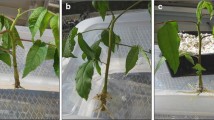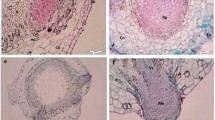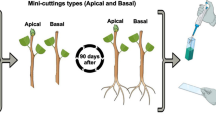Abstract
The Black pepper (Piper nigrum L.) is appreciated worldwide for its pleasant aroma and spicy flavor. New plants are established by vegetative propagation of stem cuttings and addition of growth regulators to improve rooting. Here, we aimed to evaluate the influence of tendrils and indole-3-butyric acid (IBA) on the anatomy and adventitious rooting of cuttings from three black pepper cultivars, namely ‘Bragantina’, ‘Guajarina’, and ‘Iaçará’. The following variables were assessed: survival percentage; sprouting; total, basal, and nodal rooting; number and length of basal, nodal, and total roots; and total root volume. The highest rooting rates (76.4%) were recorded in IBA-treated cuttings lacking tendrils, highlighting the potential of ‘Guajarina’ (81.1%) and ‘Iaçará’ (78.6%). Histological analyses revealed the presence of perivascular fibers and lignification of the collenchyma, which might have restrained rhizogenesis in the cuttings. Histochemical analysis revealed reduced levels of starch in the cuttings of ‘Bragantina’, which might explain the significantly low rooting rates, with starch concentration described by the color code as common in the pith and rare in the cortex, phloem and xylem.










Similar content being viewed by others
Data Availability
The datasets generated during and/or analyzed during the current study are available from the corresponding author on reasonable request.
Code Availability
Not applicable.
Abbreviations
- Ss :
-
Sclerenchymatous sheath
- Cx :
-
Cortex
- Pi :
-
Pith
- Rp :
-
Radial parenchyma
- SXy :
-
Secondary xylem
- Sb :
-
Sclerenchymatous bundle
- Mb :
-
Medullar bundle
- Pf :
-
Perivascular fibers
- Co :
-
Collenchyma
- Ep :
-
Epidermis
- Vb :
-
Vascular bundle
- Vc :
-
Vascular cylinder
- En :
-
Endodermis
- Ph :
-
Phloem
- P :
-
Pericycle
- Cp :
-
Cortical parenchyma
- X :
-
Xylem
References
Agulló-Antón MA, Sánchez-Bravo J, Acosta M, Druege U (2011) Auxin or sugars: what makes the difference in the adventitious rooting of stored carnation cuttings? J Plant Growth Regul 30:100–113
Almeida MR, Schwambach J, Silveira V, Heringer AS, Fett JP, Fett-Neto AG (2020) Proteomic profiles during adventitious rooting of Eucalyptus species relevant to the cellulose industry. New for 51:213–241
Aloni R (2013) Role of hormones in controlling vascular differentiation and the mechanism of lateral root initiation. Planta 238:819–830
Alvares CA, Stape JL, Sentelhas PC, Gonçalves JLM, Sparovek G (2013) Köppen’s climate classification map for Brazil. Meteorol Z 22:711–728
Anith KN, Aswini S, Varkey S, Radhakrishnan NV, Nair DS (2018) Root colonization by the endophytic fungus Piriformospora indica improves growth, yield and piperine content in black pepper (Piper nigurm L.). Biocatal Agric Biotechnol 14:215–220
Bag A, Chattopadhyay RR (2018) Evaluation of antioxidant potential of essential oils of some commonly used Indian spices in in vitro models and in food supplements enriched with omega-6 and omega-3 fatty acids. Environ Sci Pollut Res 25:388–398
Boss PK, Thomas MR (2002) Association of dwarfism and floral induction with a grape ‘green revolution’ mutation. Nature 416:847–850
Bryant PH, Trueman SJ (2015) Stem anatomy and adventitious root formation in cuttings of Angophora, Corymbia and Eucalyptus. Forests 6:1227–1238
Chen Y, Ghanem ME, Siddique KHM (2016) Characterising root trait variability in chickpea (Cicera rietinum L.) germplasm. J Exp Bot 68:1987–1999
Cruz CD (2016) Genes software—extended and integrated with the R, Matlab and Selegen. Acta Sci. Agron 38:547–552
Cunha ALB, Chaves FCM, Batista AC, Hidalgo AF (2015) Propagação vegetativa de estacas de Piper hispidum Sw. em diferentes substratos. Rev Bras Pl Med 17:685–692
Denaxa NK, Vemmos SN, Roussos PA (2012) The role of endogenous carbohydrates and seasonal variation in rooting ability of cuttings of an easy and a hard to root olive cultivars (Olea europaea L.). Sci Hortic 143:19–28
Dousseau S, Alvarenga AA, Alves E, Chaves IS, Souza ES, Alves JS (2011) Physiological, morphological and biochemical characteristics of the sexual propagation of Piper aduncum (Piperaceae). Rev Bras Bot 34:297–305
Freire RR, Schmildt ER, Lopes JC, Chagas K, Marques HIP, Cardoso Filho J, Oliveira JPB, Otoni WC, Alexandre RS (2017) Rooting responses of black pepper (Piper nigrum cv. Bragantina) as affected by chemical, physical and microbiological properties of substrates and auxin. Aust J Crop Sci 11:126–133
Freire RR, Alexandre RS, Ramos MPP, Chagas K, Lopes JC, Oliveira JPB, Araujo CP, Assis ISA (2018) Diagnóstico da produção de mudas de pimenteira-do-reino no Norte do Espírito Santo. In: Silva MB, Vitória EL, Campanharo A (Org). Cultura da pimenteira-do-reino.São Mateus-ES: Gráfica Araçá-ME, pp. 128.
Gauch HG, Dugger WM (1953) The role of boron in the translocation of sucrose. Plant Physiol 28:457–466
Gomes EN, Krinski D (2016) Propagação vegetativa de Piper amalago L. (Piperaceae) em função de tipos de estaca e substratos. Cult Agron: Rev Ciênc Agron 25:199–210
Guan L, Li Y, Huang K, Cheng ZM (2020) Auxin regulation and MdPIN expression during adventitious root initiation in apple cuttings. BioRxiv 1:1–21
Hartmann HT, Kester DE, Junior Davies FT (2011) Geneve RL (2011) plant propagation: principles and practices, 8th edn. Englewood Clipps, New Jersey, p 900
Husen A, Pal M (2007) Metabolic changes during adventitious root primordium development in Tectona grandis Linn. F. (teak) cuttings as affected by age of donor plants and auxin (IBA and NAA) treatment. New for 33:309–323
Johansen DA (1940) Plant microtechnique. Mc Graw Hill, New York, p 523
Lau ET, Khew CY, Hwang SS (2020) Transcriptomic analysis of pepper plants provides insights into host responses to Fusarium solani infestation. J Biotechnol 314–315:53–62
Luz SFM, Yamaguchi LF, Kato MJ, Lemos OF, Xavier LP, Maia JGS, Ramos AR, Setzer WN, Silva JKFR (2017) Secondary metabolic profiles of two cultivars of Piper nigrum (black pepper) resulting from infection by Fusarium solani f. sp. piperis. Int J Mol Sci 18:24–34
Magevski GC, Czepak MP, Schmildt ER, Alexandre RS, Fernandes AA (2011) Propagação vegetativa de espécies silvestres do gênero Piper, com potencial para uso como porta enxertos em pimenta-do-reino (Piper nigrum). Rev Bras Pl Med 13:559–563
Malabarba J, Reichelt M, Pasquali G, Mithöfer A (2019) Tendril coiling in grapevine: Jasmonates and a new role for GABA? J Plant Growth Regul 38:39–45
Mayer JLS, Biasi LA, Bona C (2006) Capacidade de enraizamento de estacas de quatro cultivares de Vitis L. (Vitaceae) relacionada com os aspectos anatômicos. Acta Bot Bras 20:563–568
Pandit C, Anilakumar KR (2017) Cold adaptive thermogenesis following consumption of certain pungent spice principles: a validation study. J Therm Biol 64:35–40
Pescador R, Voltoni AC, Girardi CG, Rosa FAF (2007) Estaquia de pariparoba-do-Rio Grande do Sul sob efeito do ácido indol-butírico em dois substratos. Sci Agrar 8:391–398
Pfister B, Zeeman SC, Rugen MD, Field RA, Ebenhöh O, Raguin A (2020) Theoretical and experimental approaches to understand the biosynthesis of starch granules in a physiological context. Photosynth Res 145:55–70
Santos VLP, Franco CRC, Amano E, Messias-Reason IJ, Budel JM (2015) Anatomical investigations of Piper amalago (jaborandi-manso) for the quality control. Rev Bras Farmacogn 25:85–91
Secundino W, Alexandre RS, Schmildt ER, Schmildt O, Magevisk GC, Martins JPR (2014) Rhizogenic behavior of black pepper cultivars to índole-3-butyric acid. Acta Sci. Agron 36:355–364
Secundino W, Alexandre RS, Schmildt ER, Schmildt O, Marques HIP (2018) Substrates on the cuttings rooting of black pepper genotypes. Comun Sci 9:621–628
Serrano LAL, Lima IM, Martins MVV (2006) A cultura da pimenteira-do-reino do Estado do Espírito Santo. Vitória, INCAPER, pp. 36.
Serrano LAL, Marinato FA, Magiero M, Sturm GM (2012) Produção de mudas de pimenteira-do-reino em substrato comercial fertilizado com adubo de liberação lenta. Rev Ceres 59:512–517
Shityakov S, Bigdelian E, Hussein AA, Hussain MB, Tripathi YC, Khan MU, Shariati MA (2019) Phytochemical and pharmacological attributes of piperine: a bioactive ingredient of black pepper. Eur J Med Chem 176:149–161
Silva JM, Raposo A, Sousa JA, Miranda EM (2004) Indução de enraizamento em estacas de joão-brandinho (Piper sp.) com ácido indolbutírico. Rev Cienc Agron 35:248–252
Sousa AI, Ferreira IMPLVO, Faria MA (2019) Sensitive detection of Piper nigrum L. adulterants by a novel screening approach based on qPCR. Food Chem 283:596–603
Sousa-Baena MS, Sinha NR, Hernandes-Lopes J, Lohmann LG (2018) Convergent evolution and the diverse ontogenetic origins of tendrils in angiosperms. Front Plant Sci 9:1–19
Souza LA, Moscheta IS, Mourão KSM, Albiero ALM, Iwazaki MC, Oliveira JHG, Rosa SM (2009) Vegetative propagation in Piperaceae species. Braz Arch Biol Technol 52:1357–1361
Srinivasan C, Mullins MG (1979) Flowering in Vitis: conversion of tendrils into inflorescences and bunches of grapes. Planta 145:187–192
Tchoundjeu Z, Avana ML, Leakey RRB, Simons AJ, Assah E, Duguma B, Bell JM (2002) Vegetative propagation of Prunus africana: effects of rooting medium, auxin concentrations and leaf area. Agrofor Syst 54:183–192
Vilasboa J, Costa CT, Fett-Neto AG (2019) Rooting of eucalypt cuttings as a problem-solving oriented model in plant biology. Prog Biophys Mol Biol 146:85–97
Yang P, Liu Z, Zhao Y, Cheng Y, Li J, Ning J, Yang Y, Huang J (2020) Comparative study of vegetative and reproductive growth of different tea varieties response to different fluoride concentrations stress. Plant Physiol Biochem 154:419–428
Acknowledgements
We thank Eliseu Bonomo for kindly making the collection of P. nigrum cultivars available for the development of the research. Editage (www.editage.com) is also acknowledged for English language editing.
Funding
This work was supported by the National Council for Scientific and Technological Development (CNPq, Brasília, DF, Brazil: Scientific Initiation Scholarship to ALS).
Author information
Authors and Affiliations
Contributions
RSA, CPA, and ALS designed the study; CPA, ALS, EMA, TM, TLMR, and RB performed most of the experiments; ALS, EMA, and CEVR performed histological studies; ERS analyzed the data; RSA, CPA, ERS, JCL, JPBO and WCO wrote the article with input from all other authors. All authors read and approved the manuscript.
Corresponding author
Ethics declarations
Conflict of interest
The authors declare no conflict of interest.
Ethical Approval
Not applicable.
Consent for Publication
All authors are aware of the publication.
Consent to Participate
All authors are aware of the publication.
Additional information
Handling Editor: Stephen Werbrouck.
Publisher's Note
Springer Nature remains neutral with regard to jurisdictional claims in published maps and institutional affiliations.
Rights and permissions
Springer Nature or its licensor (e.g. a society or other partner) holds exclusive rights to this article under a publishing agreement with the author(s) or other rightsholder(s); author self-archiving of the accepted manuscript version of this article is solely governed by the terms of such publishing agreement and applicable law.
About this article
Cite this article
Alexandre, R.S., de Araujo, C.P., Siqueira, A.L. et al. Influence of Tendrils and IBA on Rhizogenic Responses in Cuttings of Black Pepper Cultivars: Histological and Histochemical Aspects. J Plant Growth Regul 42, 4083–4094 (2023). https://doi.org/10.1007/s00344-022-10871-3
Received:
Accepted:
Published:
Issue Date:
DOI: https://doi.org/10.1007/s00344-022-10871-3




